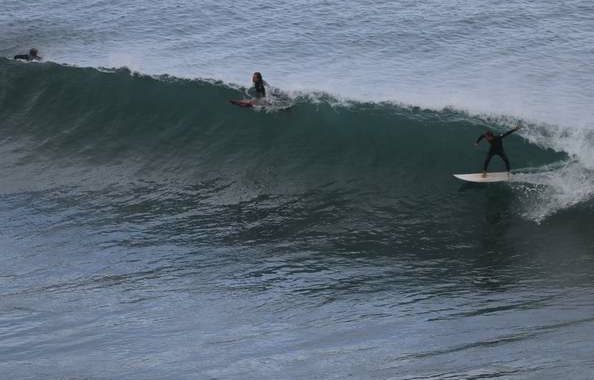What makes Bells break?
Late in the 1940s, two local surfers trekked through the bush to surf Bells Beach for the first time.
Since then, the Bells break has earned its place in the world’s hall of fame.
Professional surfer and director of editorial at Surfline Australia Nick Carroll is one surfer who has an intricate knowledge of Bells – both from the water and land.
As a competitive surfer, Carroll has won several contests at Bells, including a recent national title.
As the editor of Surfline in Australia, a company that specialises in surf forecasting and surf reports, Carroll has an intricate understanding of the environmental factors that affects the waves at Bell’s.
According to Carroll, Bells is uniquely positioned to make the most of the long-period Southern Ocean swells and weather patterns created by storms that girdle the fringes of Antarctica — the Roaring Forties and the Furious Fifties.
“Bells is so close to that storm’s edge,” Carroll said.
“But it’s also far enough away that the winds can often be really good for surfing at the same time.”
He said the north-westerlies often associated with this weather patterns are perfect for the south-east-facing coastline — providing offshore winds as a huge storm swell is delivered.
“Bells is just far enough north to be to be mostly clear of the worst of the wind.
“It’s inside the Bass Strait, and the whole coast is turned a little bit away from that wind, but the swell is still big enough that it will still wrap around into the Bass Strait and into those reefs.
“If you were a bit further south, say in Tasmania, at that time you’re just getting smashed by raging southwest winds.”
Carroll said the shape of the sea floor – the seabed topography known as bathymetry – was also an important part of why the wave breaks the way it does.
The reefs at Bells provide the perfect contour to harness these Southern Ocean swells while maintaining the wave’s characteristic shape.

“That shelving reef is shaped to cause the wave to break in a long sloping wall, which is really what you want for surfing,” Carroll said.
Further out to sea, Southern Ocean swell lines travel from the epicentre of a storm and bend around Tasmania, funnelling into Bass Strait.
“The shelving reefs slope really beautifully out to sea out to the south… they bend and refract the swells into Bells Beach and its nearby neighbour Winki Pop,” Carroll said.
Because of this, Carroll said the best conditions at Bells are usually six to eight foot, with light north-west winds and a south-south-west swell direction, often with a low tide.
“A slightly more south angle in the swell tends to refract the wave really well on the Bells reefs.”
In ideal conditions, the long, slow walls can start at Rincon and, with a quivering lip, connect through all the way into the Bowl.
“It’s surprisingly consistent wave as far as its shape goes.
It will kind of maintain a really consistent shape from just waist high to double overhead,” Carroll said.
“It rarely shows its dangerous side… it’s not a frightening wave like Pipeline in Hawaii.”
Unlike many waves on the Championship Tour, Bells is not a hollow wave and competitors can’t rely on barrel riding to score points in competitions.
“It is a wave that throws up a real challenge to a highly skilled surfer,” Carroll said.
“Probably the biggest challenge at Bells for modern surfers is to slow their pace of their surfing down enough to fit in the wave, so not to constantly run out in front of it or look for something that the wave won’t provide.
“They have to work out how to time all their turns really well to fit the wave and some surfers really get a hang of that, and other people, despite being really reputable, really struggle to find that rhythm with the wave.
So, it’s a talent.
“That’s really the key to Bells – watching it really closely for an hour or so before you surf so you don’t



















